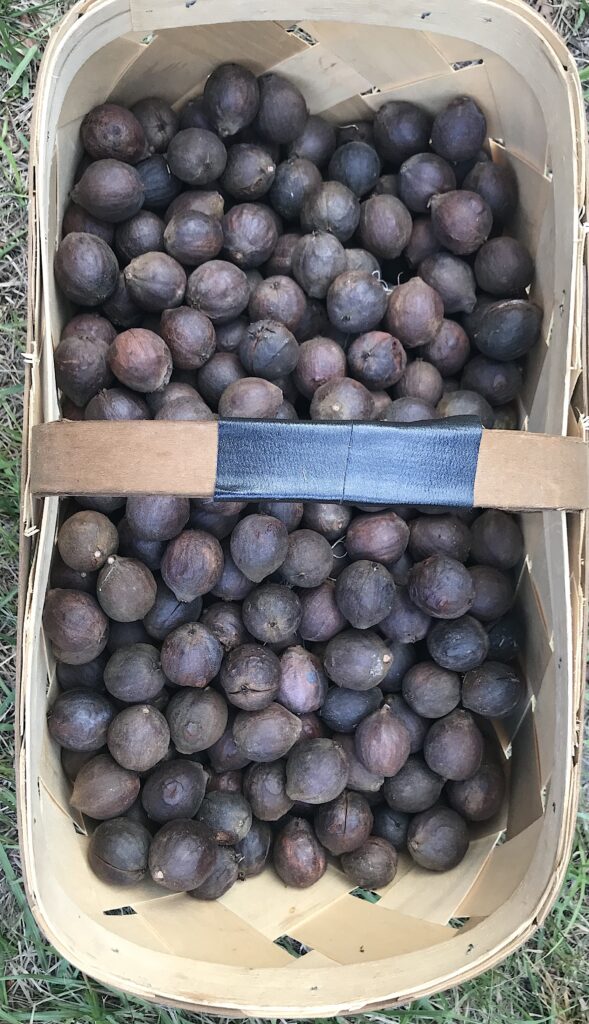
Eaten by humans, ignored by goat and usually deer, hickory nut meat is quite tasty. Photo by Green Deane
I know a Nubian milk goat that likes bananas. I usually deliver that treat to her under a hickory tree. The hickory nuts on the ground are all but ignored her and her Capran pals. Most hickory nuts are not good for goats. If underfed, goats might try them. Indeed most poisoning among domesticated animals happens when they are starving. There are also a few examples of that among wild animals (which usually involves famished mountain sheep eating lichen.)
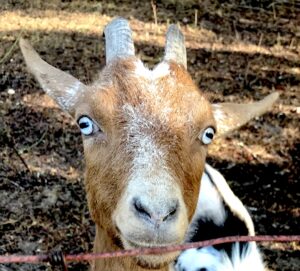
Where’s my banana? Photo by Green Deane
As the hickory nuts are not fare for the fair goat, they are a find for me and thee. I carried a couple of bags of them to my foraging class Sunday. Locally the big question is “is it a hickory or pecan?” If wild it is usually a hickory (further north a black walnut, way further north a butternut.) Locally pecans are usually planted although they can be found in the wild as well, often along river valleys. Hickories are more common. The pecan nut is oblong and has six seams, hickory is usually round with four seams. If in a very damp location (swwamp) and the hickory is over 100 feet high that is a water hickory which has bitter nutmeat. That bitterness can be leached out, similarly to acorns.
If you think nut milk is a modern innovation know native American pounded hickory nuts into fine pieces and soaked them in water to get a milky liquid they called pawcohiscora (the latter half — hiscora — is from where we get the word hickory.) I used to see a lot of black walnuts while hiking in the Washington DC area. In Maine where I grew up the butternut was king, it was my mother’s most favored wild snack, and nothing was as great as homemade butternut ice cream (a close second is the commercial maple-walnut ice cream.) Unfortunately many Butternuts in the northeast are suffering from a disease.

Homemade pumpkin pie. Photo by Green Deane.
What is the difference between a gourd and a squash or a melon et cetera. That crossed my mind as I made pumpkin pies this past week using my grandmother’s 1942 cook book. Gourds usually have tough AND bitter rinds, the rest do not (id est squash, melons et cetera.) By the way the pies came out tasting just right — which for me was a blast from the 60-year past — but they gave me heartburn — ya can’t eat just one! It was a fare trade. You can read about the melons we see in local citrus groves here.
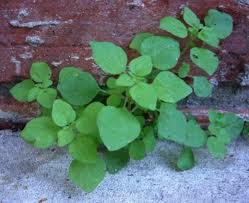
Pellitory is starting its winter run. Photo by Green Deane.
During a recent foraging class in Melbourne we saw inch-high sprouts of the winter edible Pellitory. This shade-loving perennial shows up when fall weather starts and stays around until at least mid-spring. Some years in very shady places you can find old straggling specimens as late as July. It smells and tastes like cucumber thus is also called Cucumber Weed. It’s not a plant you find in the middle of a sunny field. Look for it in shady places like under bridges and big trees To read more about this winter comestible go here.
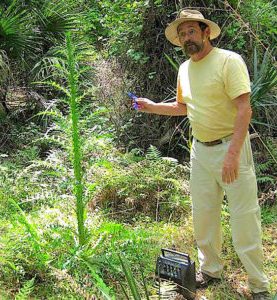
Foraging classes are held rain or shine, heat or cold. Photo by Nermina Krenata
While I have seen few wild mustards yet this season (just hairy bitter cress) this is the time of year for spring and summer perennial up north to start their seasonal run in the south. This includes sow thistles, mustards and dandelions which we saw in Melbourne. As for classes We are visiting the west of the state this week and the east next week.
Saturday November 5th, John Chestnut County Park: 2200 East Lake Road, Palm Harbor, FL
Saturday November 6th, Eagle Park Lake, 1800 Keene Road, Largo, FL 33771
Sunday November 12th, Blanchard Park, 10501 Jay Blanchard Trail, Orlando, FL 32817.
Sunday November 13th, Florida State College, south campus, 11901 Beach Blvd., Jacksonville, 32246.
For more information about the classes, to pre-pay, or to sign up go here. For all communication with me use GreenDeane@gmail.com
It is also time to mark your calendar for my 12th annual Urban Crawl. It will be Friday December 23rd at 10 a.m. in Winter Park, Florida. We meet in front of Panera’s. It’s difficult to believe I’ve had that walk for twelve years now. The Urban Crawl is free to all.
Florida’s beaches this time of year start to collect dead seaweed. It is nearly all one species, Sargassum; edible but not the tastiest of sea vegetables. It is true that nearly all seaweeds are edible if harvested from clean water. When I lived in Japan an annual environmental demonstration was to develop photographic film from unaltered water taken from Tokyo Bay. Instead of taking a few minutes, the developing took several hours but the point was made: The bay water was polluted. Generally said there are only two non-edible seaweeds in North America.
The first is Desmarestia ligulata. It is laced with sulfuric acid but is used to make pickles. You can find it along the northwest coast of the United States. You’ll know it when you find it because it will burn your mouth. The other in North America (and Central America) is Cyanobacteria which is found in the Caribbean and linked to ciguarera poisoning. It’s not really a seaweed but is a blue-green algae found in the warmer waters. It is why one should never eat older barracuda. I should add never eat blue-green algae from fresh water either nor fish from a fresh water pond with a lot of blue-green algae. They are not on the menu. As for other parts of the world, there might be some toxic red seaweeds in the South Seas. Since most seaweed is edible, and nutritious, why isn’t it consumed more often? Taste and texture. I’ve collected Sargassum here in Florida and prepared it many ways. Semi-drying and frying isn’t too bad but Bladderwrack is better, Sea Lettuce better still. The latter makes very nice salad. Not surprisingly most land animals including birds don’t like seaweed. However, it does make good mulch and fertilizer. So while one may not use it directly in the diet it can still help sustain you with uses in the garden. During Victorian times it was highly used in English agriculture mostly as mulch and fertilizer. Here are some of my articles on seaweed: Bladderwrack, Caulpera, Codium, Gracilaria, Sargassum, Sea Lettuce, and Tape Seagrass.
While on the topic of the beach — I’m usually there this coming week for a Greek festival, a birthday, and Veterans Day — many jellyfish are edible, including some that are found in local waters. I had a friend from Taiwan who never ordered from the menu at Chinese restaurants. It was always off-the-menu and then after much discussion with the waiter and sometimes the chef. One of those chats produced a dish of jellyfish. I was hooked. It was very tasty and jellyfish can be caught while casting for other fish. (I like castnetting and am a castnet junkie.) While a substantial food I’m not sure jellyfish would qualify as a staple because catching them by hand is by chance (which does increase however when in season.) They are also mostly water and need to be dessicated immediately, not a small process. It all depends on how hungry you are and how many of them you have. You should get them live out of the water, not dead on the beach. To read about jellyfish go here
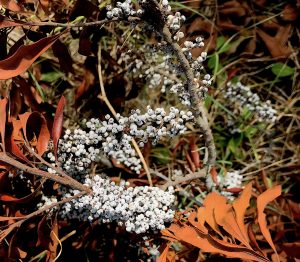
Southern Wax Myrtle berries. Photo by Green Deane
Just because you can do something doesn’t mean you should. Can you make a bayberry candle? Absolutely. Should you? If you have to, yes. If not you might want to reconsider. Southern Wax Myrtle berries are small. They have a little wax on them and why the species name is cerifera — wax producing. But it takes many gallons and a lot of hot work to get enough bayberry wax to mix with tallow (75/25) to make the famous smokeless candle that keeps away insects. No doubt hundreds of years ago it was worth it when folks had tallow from their own cattle, a lot of Bayberries and mosquitoes. Not so much today. A second method is to put some of the barries in you r canle mold then add wax and let the flame burn through the berries. You can also use the dried berries as a spice and the leaves like bay leaves or to make a tea. To read more about the Southern Wax Myrtle go here.
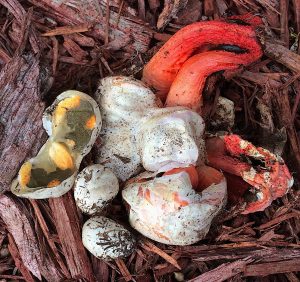
Stinkhorn Mushroom, Clathrus columnatus. Photo by Green Deane
There is a strange mushroom you can see this time of year that almost no one eats, the Column Stinkhorn. It smells like a dead animal, not exactly appetizing. The edibility of the Column Stinkhorn is also debatable. Most list it as not edible and there are reports of sickness in humans eating mature specimens. However, at least one noted expert says when in the egg stage they are mild and edible such as on the left side of the picture to the left. It takes me years of studying a mushroom before I eat it. I think this one needs more study. Their fetid aroma attracts flies which then spread the spores around. Some plants also do that. Pawpaw comes to mind. There is another smelly Stinkhorn, Phallus ravenelli. It is definitely edible when in it’s egg stage. Tastes like radish.
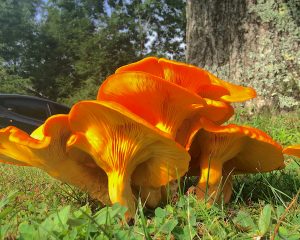
Toxic Jack O’Lanters. Photo by Green Deane
One attractive mushroom you should avoid are Jack O’Lanterns. They’re toxic and glow in the dark! A least one expert says “Jack O’ Lanterns” don’t glow in the dark but I took some home and they most certainly do. That is one of those irritation with plants. A recognized expert says one thing but your personal experience says something totally different. “Jacks” as they are called won’t kill you but they will make you very ill. I know someone who found that out personally… No, it was not me. I prefer to be non-sick. To that end I started and moderate five mushroom pages on Facebook: Southeastern US Mushroom Identification, Florida Mushroom Identification Forum, Edible Mushroom: Florida, Edible Wild Mushrooms and the Orlando Mushroom Group.

You get the USB, not the key.
Changing foraging videos: As my WordPress pages are being updated the video set will go away. They are the same videos I have on You Tube. Some people like to have a separate copy. The DVD format, however, is becoming outdated. Those 135 videos plus 36 more are now available on a USB drive. While the videos were played from the DVDs the videos on the USB have to be copied to your computer to play. They are MP4 files. The 171-video USB is $99. If you make a $99 “donation” using the link at the bottom of this page or here, that order form provides me with your address, the amount — $99 — tells me it is not a donation and is for the USB.
This is weekly newsletter #529. If you want to subscribe to this free newsletter you can find the sign-up form in the menu at the top of the page.
To donate to the Green Deane Newsletter click here.


I have several Pawpaw trees of varied lineage, but none smell fetid. I made the observation a few years ago that the trees did not set fruit well. I cut off a limb on a nearby maple and the wound was covered with large black flies. I had a better Pawpaw crop that year. Putting two together with two I sprayed diluted maple syrup on my trees and got a bumper crop. If you see a Pawpaw patch, look for a big maple tree and see if there is a symbiotic relationship there. Thanks for your work.
FYI – I am posting this again, as this blog post is more recent and I wanted to make sure you and your readers saw my message. Again, please feel free to contact me to discuss more. Thx, Vincent
Dear Mr. Deane,
My name is Vincent Encomio. I received a link to your blog from a local Master Gardener here in Stuart, FL. I am a UF IFAS and FL Sea Grant extension agent for Martin and St. Lucie counties in Florida currently doing work related to Sargassum, as it’s an emerging problem on the Treasure Coast (Martin, St. Lucie, Indian River counties), especially at one beach in Fort Pierce. It’s already a well established problem further south and especially in the Caribbean. I have been working with a team looking at Sargassum composting, a project we just completed. I don’t know if you have learned this recently, but Sargassum spp. are well known to bio-accumulate arsenic from the environment and levels can be quite high, much higher than what would be safe to consume. We actually measured arsenic content in Sargassum compost because we were (still are) concerned about its use for growing food. Although arsenic did decrease over time, there were still amounts present. There was also a recently completed study in the Caribbean, where they saw arsenic accumulate in vegetables grown with Sargassum-amended soil. This is quite concerning so I have been recommending that people do not use Sargassum compost to grow food, let alone eat it directly. It is likely fine for landscape plants, but there are questions on how pollinators could be affected if Sargassum was used to grow flowers – still unanswered. I would love to share our findings with you and talk about other work I am doing with Sargassum. But I just wanted to make sure you and your readers are aware of the danger of eating Sargassum directly due to the high arsenic contents that those spp. are known to accumulate. I’d love to talk to you more about all this. You have my email address, but I will leave it in the body of this message as well for the benefit of your readers. It is vencomio@ufl.edu. Again, please contact me.
Thanks,
Vincent
Hello again Mr. Deane,
Here is some other research from UM regarding another concern over consuming Sargassum: https://news.miami.edu/stories/2019/08/studying-the-surging-seaweed-that-is-sargassum.html
In short, elevated levels of enterococci bacteria have been linked to excessive amounts of Sargassum on beaches. Enterococcus is a bacterial indicator of fecal contamination sampled regularly by the FL Dept. of Health.
Vincent